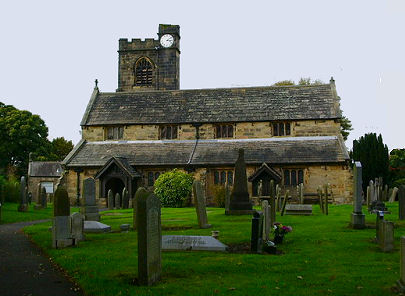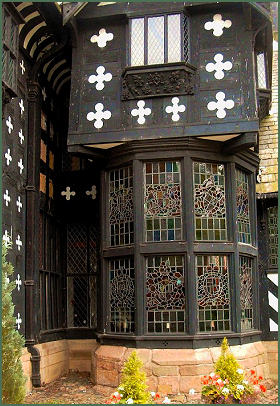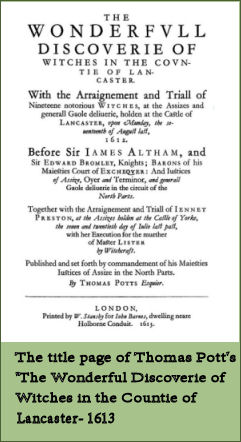Samlesbury
OS Grid ref:- SD 5898430362
 The small Lancashire village of Samlesbury lies in the bourough of South Ribble and lies around 6 miles to the east of Preston. The village derives its name from the Anglo-Saxon words, sceamol, meaning ledge and burh meaning fortification, literally "ledge fortification.
The small Lancashire village of Samlesbury lies in the bourough of South Ribble and lies around 6 miles to the east of Preston. The village derives its name from the Anglo-Saxon words, sceamol, meaning ledge and burh meaning fortification, literally "ledge fortification.
A church has occupied the site of t he village church of St. Leonard the Less (pictured left) since the twelfth century, traces of which can still be seen in the present structure. The chapel may have been rebuilt in the fourteenth century. It was substantially rebuilt in 1558, by Edward Stanley, 3rd Earl of Derby and was restored in 1885. The church has a Norman tub font, a medieval bell and funerary armour once belonging to Sir Thomas Southworth which dates from 1546. It also has a church chest, a two-decker pulpit a box pews dating from the seventeenth and eighteenth centuries, the earliest of these dates from 1678.
 Picturesque Samlesbury Hall (pictured right) was built by Gilbert de Southworth in 1325, possibly to replace the earlier building.
He acquired the Salmesbury lands through his marriage to the heiress Alicia de Ewyas. Another Gilbert de Southworth appears to have fought at the Battle of Agincourt, the famous English victory on 25 October 1415. It is not known whether he survived that conflict. In around 1420, Sir Thomas Southworth was given permission to build a chapel at the hall , which is said to be dedicated to St. Michael. The Hall over time had additional constructions and outbuildings added by the Southworth family, Thomas de Southworth, Gilbert's great grandson, who fought in the battle of Flodden, built the west wing of the house, the oriel bay and the screen.
Picturesque Samlesbury Hall (pictured right) was built by Gilbert de Southworth in 1325, possibly to replace the earlier building.
He acquired the Salmesbury lands through his marriage to the heiress Alicia de Ewyas. Another Gilbert de Southworth appears to have fought at the Battle of Agincourt, the famous English victory on 25 October 1415. It is not known whether he survived that conflict. In around 1420, Sir Thomas Southworth was given permission to build a chapel at the hall , which is said to be dedicated to St. Michael. The Hall over time had additional constructions and outbuildings added by the Southworth family, Thomas de Southworth, Gilbert's great grandson, who fought in the battle of Flodden, built the west wing of the house, the oriel bay and the screen.
The Samlesbury witches —Jane Southworth, Jennet Brierley, and Ellen Brierley—were accused of child murder and cannibalism, they were accused by a 14-year-old girl, Grace Sowerbutts. Their trial at Lancaster Assizes in England on 19 August 1612 was one in a series of witch trials held there over two days, among the most famous in English history Their trial was in the same series of trials as the Pendle witches.
The trial of the Salmesbury witches took place on 19 August 1612, the presiding judge was Sir Edward Bromley. Prior to the trial, Bromley ordered the release of five of the eight defendants from Samlesbury, with a warning about their future conduct.The remaining three , Jane Southworth, Jennet Bierley, and Ellen Bierley, were accused of using "diverse devillish and wicked Arts, called Witchcrafts, Inchauntments, Charmes, and Sorceries, in and upon one Grace Sowerbutts", they all pleaded not guiltyto the charge. The fourteen year old Grace was the chief prosecution witness.
 The evidence of Grace was heard first. In her statement to the authorities she claimed that both her grandmother and aunt, Jennet and Ellen Bierley, were able to transform themselves into dogs and that they had "haunted and vexed her" for years. She further alleged that they had transported her to the top of a hayrick by her hair, and on another occasion had tried to persuade her to drown herself. According to Grace, her relatives had taken her to the home of Thomas Walshman and his wife, from whom they had stolen a baby to suck its blood. Grace claimed that the child died the following night, and that after its burial at Samlesbury Church Ellen and Jennet dug up the body and took it home, where they cooked and ate some of it and used the rest to make an ointment that enabled them to change themselves into other shapes.
The evidence of Grace was heard first. In her statement to the authorities she claimed that both her grandmother and aunt, Jennet and Ellen Bierley, were able to transform themselves into dogs and that they had "haunted and vexed her" for years. She further alleged that they had transported her to the top of a hayrick by her hair, and on another occasion had tried to persuade her to drown herself. According to Grace, her relatives had taken her to the home of Thomas Walshman and his wife, from whom they had stolen a baby to suck its blood. Grace claimed that the child died the following night, and that after its burial at Samlesbury Church Ellen and Jennet dug up the body and took it home, where they cooked and ate some of it and used the rest to make an ointment that enabled them to change themselves into other shapes.
Grace further alleged that her grandmother and aunt, with Jane Southworth, attended sabbats held every Thursday and Sunday night at Red Bank, on the north shore of the River Ribble. At those secret meetings they met with "foure black things, going upright, and yet not like men in the face", with whom they ate, danced, and had sex. The evidence of Thomas Walshman, the father of the baby allegedly killed, was hear next. He confirmed that his child had died of unknown causes at about one year old. He added that Grace Sowerbutts was discovered lying as if dead in his father's barn on about 15 April, and did not recover until the following day. Two other witnesses, John Singleton and William Alker, confirmed that Sir John Southworth, Jane Southworth's father-in-law, had been reluctant to pass the house where his son lived, as he believed Jane to be an "evil woman, and a Witch".
Thomas Potts, the clerk to the Lancaster Assizes, reported that after hearing the evidence many of those present in court were persuaded of the three women's guilt. On being questioned by the judge what answer they could make to the charges laid against them, the three defendants "humbly fell upon their knees with weeping teares", and "desired him [Bromley] for Gods cause to examine Grace Sowerbutts". Immediately, Potts goes on to record "the countenance of this Grace Sowerbutts changed"; the witnesses "began to quarrel and accuse one another", and eventually admitted that Grace had been coached in her avccount of the affair by a Catholic priest they called Thompson. Bromley then committed the girl to be examined by two JPs, William Leigh and Edward Chisnal. Under questioning Grace admitted that her story was untrue, and added that she had been coached what to say by Jane Southworth's uncle, Christopher Southworth aka Thompson, a Jesuit priest who was in hiding in the Samlesbury area. Southworth was the chaplain at Samlesbury Hall. After the statements had been read out in court Bromley ordered the jury to find the defendants not guilty.
Nearby Places of Interest
The Ribble Valley, nicknamed 'Little Switzerland' boasts some of the most attractive scenery in Lancashire. Much of the valley is contained within within the Forest of Bowland, an Area of Outstanding Natural Beauty.
Whalley Abbey, a former Cistercian abbey, situated in the large village of Whalley in the Ribble Valley in Lancashire.
